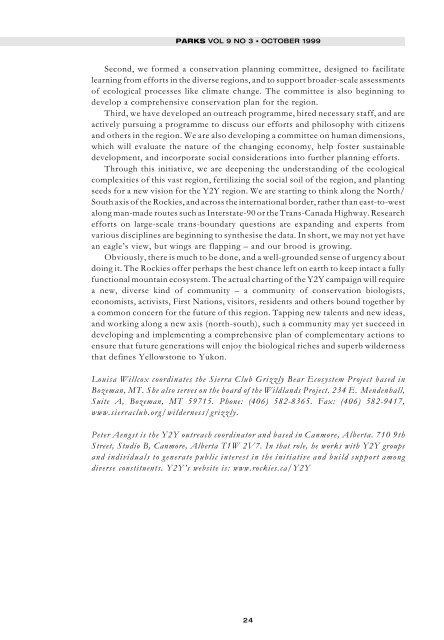Parks - IUCN
Parks - IUCN
Parks - IUCN
Create successful ePaper yourself
Turn your PDF publications into a flip-book with our unique Google optimized e-Paper software.
PARKS VOL 9 NO 3 • OCTOBER 1999<br />
Second, we formed a conservation planning committee, designed to facilitate<br />
learning from efforts in the diverse regions, and to support broader-scale assessments<br />
of ecological processes like climate change. The committee is also beginning to<br />
develop a comprehensive conservation plan for the region.<br />
Third, we have developed an outreach programme, hired necessary staff, and are<br />
actively pursuing a programme to discuss our efforts and philosophy with citizens<br />
and others in the region. We are also developing a committee on human dimensions,<br />
which will evaluate the nature of the changing economy, help foster sustainable<br />
development, and incorporate social considerations into further planning efforts.<br />
Through this initiative, we are deepening the understanding of the ecological<br />
complexities of this vast region, fertilizing the social soil of the region, and planting<br />
seeds for a new vision for the Y2Y region. We are starting to think along the North/<br />
South axis of the Rockies, and across the international border, rather than east-to-west<br />
along man-made routes such as Interstate-90 or the Trans-Canada Highway. Research<br />
efforts on large-scale trans-boundary questions are expanding and experts from<br />
various disciplines are beginning to synthesise the data. In short, we may not yet have<br />
an eagle’s view, but wings are flapping – and our brood is growing.<br />
Obviously, there is much to be done, and a well-grounded sense of urgency about<br />
doing it. The Rockies offer perhaps the best chance left on earth to keep intact a fully<br />
functional mountain ecosystem. The actual charting of the Y2Y campaign will require<br />
a new, diverse kind of community – a community of conservation biologists,<br />
economists, activists, First Nations, visitors, residents and others bound together by<br />
a common concern for the future of this region. Tapping new talents and new ideas,<br />
and working along a new axis (north-south), such a community may yet succeed in<br />
developing and implementing a comprehensive plan of complementary actions to<br />
ensure that future generations will enjoy the biological riches and superb wilderness<br />
that defines Yellowstone to Yukon.<br />
Louisa Willcox coordinates the Sierra Club Grizzly Bear Ecosystem Project based in<br />
Bozeman, MT. She also serves on the board of the Wildlands Project. 234 E. Mendenhall,<br />
Suite A, Bozeman, MT 59715. Phone: (406) 582-8365. Fax: (406) 582-9417,<br />
www.sierraclub.org/wilderness/grizzly.<br />
Peter Aengst is the Y2Y outreach coordinator and based in Canmore, Alberta. 710 9th<br />
Street, Studio B, Canmore, Alberta T1W 2V7. In that role, he works with Y2Y groups<br />
and individuals to generate public interest in the initiative and build support among<br />
diverse constituents. Y2Y’s website is: www.rockies.ca/Y2Y<br />
24

















